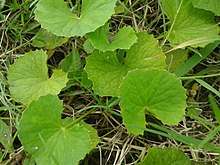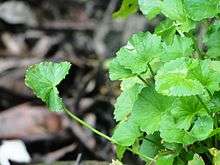Centella asiatica
| Centella asiatica | |
|---|---|
 | |
| Scientific classification | |
| Kingdom: | Plantae |
| Clade: | Angiosperms |
| Clade: | Eudicots |
| Clade: | Asterids |
| Order: | Apiales |
| Family: | Apiaceae |
| Genus: | Centella |
| Species: | C. asiatica |
| Binomial name | |
| Centella asiatica | |
| Synonyms[1] | |
Centella asiatica, commonly known as centella, Asiatic pennywort or Gotu kola, is a herbaceous, frost-tender perennial plant in the flowering plant family Apiaceae.[2] It is native to wetlands in Asia.[3][4] It is used as a culinary vegetable and as a medicinal herb.[2]
Description

Centella grows in temperate and tropical swampy areas in many world regions.[2][5] The stems are slender, creeping stolons, green to reddish-green in color, connecting plants to each other. It has long-stalked, green, rounded apices which have smooth texture with palmately netted veins. The leaves are borne on pericladial petioles, around 2 cm (0.79 in). The rootstock consists of rhizomes, growing vertically down. They are creamish in color and covered with root hairs.[6]
The flowers are white or pinkish to red in color, born in small, rounded bunches (umbels) near the surface of the soil. Each flower is partly enclosed in two green bracts. The hermaphrodite flowers are minute in size, less than 3 mm (0.12 in), with five to six corolla lobes per flower. Each flower bears five stamens and two styles. The fruit are densely reticulate, distinguishing it from species of Hydrocotyle which have smooth, ribbed or warty fruit.[4] The crop matures in three months, and the whole plant, including the roots, is harvested manually. It is a highly invasive plant, rated as "high risk".[2] Centella has numerous common names in its regions of distribution.[2]
Habitat
Centella asiatica is indigenous to the Indian subcontinent, Southeast Asia, and wetland regions of the Southeastern US.[7][8] Because the plant is aquatic, it is especially sensitive to biological and chemical pollutants in the water, which may be absorbed into the plant. It can be cultivated in drier soils as long as they are watered regularly enough (such as in a home garden arrangement).
Chemistry

Centella contains pentacyclic triterpenoids, including asiaticoside, brahmoside, asiatic acid, and brahmic acid (madecassic acid). Other constituents include centellose, centelloside, and madecassoside.[9][10][11]
Culinary use
In Myanmar cuisine, raw pennywort is used as the main constituent in a salad made also with onions, crushed peanuts, bean powder and seasoned with lime juice and fish sauce. Centella is used as a leafy green in Sri Lankan cuisine, being the most predominant of all locally available leafy greens, where it is called gotu kola. The adjective gotu in Sinhalese, is translated as "an inverted conical shape" (like the shape of a colander) and kola as "leaf". It is most often prepared as malluma, a traditional accompaniment to rice and curry, and goes especially well with vegetarian dishes, such as dhal, and jackfruit or pumpkin curry. It is considered nutritious. In addition to finely chopped gotu kola plants, the gotu kola malluma may contain grated coconut, diced shallots, lime (or lemon) juice, and sea salt, and may also contain finely chopped green chilis, chili powder, turmeric powder, or chopped carrots as additional ingredients. The centella fruit-bearing structures are discarded from the gotu kola malluma due to their intense bitter taste. A variation of porridge known as kola kenda is also made with gotu kola by the Sinhalese people of Sri Lanka. Gotu kola kenda is made with well-boiled red rice with some extra liquid, coconut milk first extract, and gotu kola purée. The porridge is accompanied with jaggery for sweetness. Centella leaves are also used in modern sweet "pennywort" drinks and herbal teas. In addition the leaves are served stir-fried whole in coconut oil, or cooked in coconut milk with garlic or dhal.
In Indonesia, the leaves are used for sambai oi peuga-ga, an Aceh type of salad, and is also mixed into asinan in Bogor. In Vietnam and Thailand, this leaf is used for preparing a drink or can be eaten in raw form in salads or cold rolls. In Bangkok, vendors in the famous Chatuchak Weekend Market sell it alongside coconut, roselle, chrysanthemum, orange and other health drinks. In Malay cuisine the leaves of this plant are used for ulam, a type of Malay salad.[12] Centella is widely used in various Indian regional cuisines. Among the Kukis of Northeast India, it is locally known as 'Changkong che' and is widely used as chutney along with dried red chili and fermented fish called 'nga-thu' or 'ngari'.
Traditional medicine
In traditional medicine, C. asiatica has been used to treat various disorders and minor wounds[2][13][14] and to encourage lactation,[15] but clinical efficacy and safety have not been confirmed by high-quality medical research.[13] Contact dermatitis and skin irritation are possible from topical application,[13] and headache, nausea, and drowsiness may occur from internal use.[14] The herb may have adverse effects on liver function when used over many months.[14]
In Āyurveda, C. asiatica is known as maṇḍūkaparṇī or maṇḍūkī, and is classified as a vegetable in the Carakasaṃhitā with supposed rejuvenating properties.[16]
Agriculture
In the context of phytoremediation, C. asiatica is a potential phytoextraction tool owing to its ability to take up and translocate metals from root to shoot when grown in soils contaminated by heavy metals.[17]
References
- ↑ "Pharmacological Review on Centella asiatica: A Potential Herbal Cure-all". Indian J Pharm Sci: 546–56. September 2010.
- 1 2 3 4 5 6 "Centella asiatica (Asiatic pennywort)". Invasive Species Compendium, CABI. 22 November 2017. Retrieved 2 January 2018.
- ↑ United States Department of Agriculture. "Plant Profile for Centella asiatica". Retrieved 15 July 2012.
- 1 2 Floridata. "Centella asiatica". Retrieved 15 July 2012.
- ↑ Meschino Health. "Comprehensive Guide to Gotu Kola (Centella asiatica)". Retrieved 15 July 2012.
- ↑ "Leaf Extract Treatment During the Growth Spurt Period Enhances Hippocampal CA3 Neuronal Dendritic Arborization in Rats". Evid Based Complement Alternat Med: 349–57. September 2006.
- ↑ "Centella asiatica". Alabama Plant Atlas. Retrieved 17 August 2015.
- ↑ "Centella asiatica". Atlas of Florida Vascular Plants. Retrieved 17 August 2015.
- ↑ Singh B. and Rastogi, R. P. 1969. A reinvestigation of the triterpenes of Centella Asiatica. Phytochemistry 8: 917-921.
- ↑ Singh, B. and Rastogi, R.P. 1968. Chemical examination of Centalla Asiatica Linn - III. Constitution of brahmic acid. Phytochemistry 7: 1385-1393. doi:10.1016/S0031-9422(00)85642-3
- ↑ Murray, edited by Joseph E. Pizzorno, Jr., Michael T. (2012). Textbook of natural medicine (4th ed.). Edinburgh: Churchill Livingstone. p. 650. ISBN 9781437723335.
- ↑ "Nasi ulam". Retrieved 2009-05-07.
- 1 2 3 "Gotu kola". Drugs.com. 2009. Retrieved 2 January 2018.
- 1 2 3 "Gotu kola". University of Maryland Medical Center.
- ↑ Tanaka, Yoshitaka; Van Ke, Nguyen (2007). Edible Wild Plants of Vietnam: The Bountiful Garden. Thailand: Orchid Press. p. 25. ISBN 9745240893.
- ↑ Bhagwan Dash, Vaidya (1992). Five Specialised Therapies of Ayurveda, Pancakarma. Concept Publishing Company. pp. 201–202. ISBN 978-8170223979.
- ↑ Abd Manan F, Chai TT, Abd Samad A, Mamat DD (2015) Evaluation of the phytoremediation potential of two medicinal plants. Sains Malaysiana 44(4): 503–509